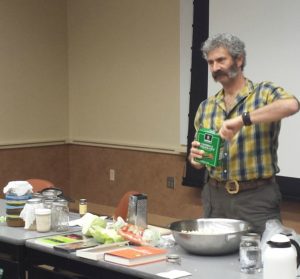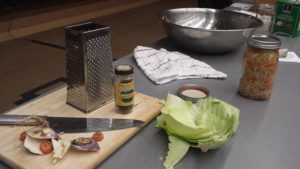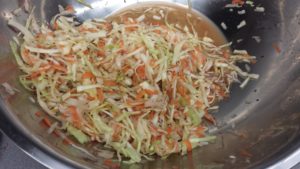“Fermentation can be an engine of social change and we are starter cultures.”
– Sandor Katz, aka Sandor Kraut
 That was the closing benediction given by Sandor Katz after a marathon four-hour fermented foods intensive workshop at the 2016 Farming for the Future Conference hosted by the Pennsylvania Association for Sustainable Agriculture (PASA). Sandor Katz is a self-described “fermentation revivalist” and begins the workshop with a description of fermentation and its many health benefits. After a short history of the wonders of cultures foods, Sandor dives into the cornerstone of this half-day event: a hands-on review of the most popular fermentation recipes, including kefir, yogurt, kombucha, sourdough, country wine, fruit kvass, ginger bug, and water kefir. The following notes are derived from Holly’s fan girl notebook, and can only attempt to serve as a somewhat reliable recollection of a starstruck encounter with a major cultural figure of our time!
That was the closing benediction given by Sandor Katz after a marathon four-hour fermented foods intensive workshop at the 2016 Farming for the Future Conference hosted by the Pennsylvania Association for Sustainable Agriculture (PASA). Sandor Katz is a self-described “fermentation revivalist” and begins the workshop with a description of fermentation and its many health benefits. After a short history of the wonders of cultures foods, Sandor dives into the cornerstone of this half-day event: a hands-on review of the most popular fermentation recipes, including kefir, yogurt, kombucha, sourdough, country wine, fruit kvass, ginger bug, and water kefir. The following notes are derived from Holly’s fan girl notebook, and can only attempt to serve as a somewhat reliable recollection of a starstruck encounter with a major cultural figure of our time!
(Please refer to Sandor’s website for more guidance on these recipes, and lots more great information!).
Fermentation is a transformative action of microorganisms. From the Latin word ferveri, to boil, fermentation is “cold boiling.” It is a mostly anaerobic process, because when exposed to air, mold dominates the environment and takes over. The key is to encourage some microbes while discouraging others. The goal is for the indigenous bacteria to dominate the outside contaminants. Acidification is good for food safety.
How have humans benefited from fermented foods?
- Enhanced health – the studies on the gut-brain connection are just beginning to demonstrate this!
- improved digestion (pre-digestion with soybeans, for example –> proteins broken down into amino acids; break down nutritive compounds)
- increased nutrient absorption, enhancement and detoxification
- better mental health
- stronger immune system (biodiversity inside counts! 1 trillion bacteria in the human body)
- Preservation of food (cheese, yogurt, kefir are all practical ways of preserving milk)
- Creation of survival foods (sauerkraut deterred sailors from getting scurvy)
- Discovery of alcohol
Fermentation creates some edgy flavors and smells, not all of which may be accessible to people, depending on their tastes and personal preferences. The origins of many fermented foods is largely unknown, and are the result of happy accidents. Fermentation is a versatile process, and takes the path of least resistance. Regular interaction with your cultures leads to better results.
In wild fermentation, you don’t have to add a starter culture; the food already has a starter. Starters can take three forms:
- Packet: has been isolated (yeast)
- “Backslopping”: an ancient form of collecting a starter, by taking part of the last batch to begin the new batch (yogurt)
- S.C.O.B.Y.: symbiotic community of bacteria and yeast, a distinctive form of cultures (kombucha, vinegar, kefir)
Fun Fermentation Fact: Ketchup is derived from the ancient Chinese word for fish sauce! (Click here to read more about that.)
Fermented Vegetables
 Are You A Beginner to Fermentation? Sandor suggests that anyone starting with fermentation should begin with vegetables. In his words, “there is no vegetable that can’t be fermented.” (Note: Cucumbers are the hardest vegetables to ferment, due to their high water content, so use the baby pickling cukes if you’re making pickles). When buying produce, avoid irradiated items like ginger and garlic, and try to purchase organic whenever possible.
Are You A Beginner to Fermentation? Sandor suggests that anyone starting with fermentation should begin with vegetables. In his words, “there is no vegetable that can’t be fermented.” (Note: Cucumbers are the hardest vegetables to ferment, due to their high water content, so use the baby pickling cukes if you’re making pickles). When buying produce, avoid irradiated items like ginger and garlic, and try to purchase organic whenever possible.
Chopping vegetables exposes more surface area, and pulls the juice out of the vegetables. Salt is helpful, but not necessary to ferment vegetables. The more salt, the crunchier the vegetables and the slower the lactic acid will work its magic. Sandor uses unrefined sea salt, but says “don’t be picky” about which salt to use. Bacteria can handle more salt than humans, so don’t worry that it may be too salty, just make sure you’ll want to eat something that salty.
 To make a basic brine, Sandor suggests combining 1 quart of water (spring water preferred) to 3 Tablespoons of salt. Try to massage/bruise/caress shredded veggies for 5 minutes in a bowl with brine. You can add water, but it will dilute the flavor. It’s essential to completely submerge the shredded veggies below the brine water line. In a large container, you can use a weight to keep the vegetables below the water line, and some companies make specific tools for this purpose. In a larger container, you can use a plate to weigh down the vegetables.
To make a basic brine, Sandor suggests combining 1 quart of water (spring water preferred) to 3 Tablespoons of salt. Try to massage/bruise/caress shredded veggies for 5 minutes in a bowl with brine. You can add water, but it will dilute the flavor. It’s essential to completely submerge the shredded veggies below the brine water line. In a large container, you can use a weight to keep the vegetables below the water line, and some companies make specific tools for this purpose. In a larger container, you can use a plate to weigh down the vegetables.
Let off air from the lid, let breath, then tighten lid and check for 3-4 days. Bacteria generates the most CO2 in the early stage. Cooler temperatures (low 60’s) are preferred for storage. If water runs out in jar, add more water to keep vegetables submerged. Based on your taste, the vegetables should be ready to eat, or you can continue to ferment them!
Fermented Dairy
Fermenting dairy improves the digestibility of milk, and is critical in its preservation. Clabbored milk is really just raw milk that’s left out and ferments.
Heirloom yogurts are available for purchase from Cultures for Health. Yogurt can be made by ‘cooking’ milk at 110 degrees for 4 hours. This is the minimum time it takes to coagulate, and the longer it’s cooked, the more lactose is digested by the bacteria. You can use raw milk to make yogurt, but it will be more liquid because you have more indigenous bacteria. When you start removing whey (milky water content), yogurt becomes a cheese.
Kefir is the champagne of yeasts. The greatest virtue of kefir is the ease of making it, but you do need to pay regular attention to your kefir grains. To make kefir, put kefir grains in jar and add milk. There are 30+ distinct organisms in kefir grains.
Fun Fermentation Fact: Immigrants would bring their dried heirloom yogurt strains to the United States on handkerchiefs. (Click here to read more.)
Fermented Grains
Fermenting grains helps break down the nutrient content and adds lightness and texture. Soak grains, wash, blend grains with a little water and let rise. Bake. Sourdough pancakes with shredded vegetables make for a wonderful savory meal.
Fermented Beverages
Don’t be intimidated by equipment- it’s not really necessary to ferment beverages. *Warning: bottles can explode so be careful not to allow too much pressure to build up!* You can use large plastic soda bottles to feel the give and resistance as fermentation continues.
Mead
All honey has yeast in it, unless it’s been heated. Honey contains 17% water. To make mead, combine 1 part honey to 4 parts water. Depending on which culture you use, the proportions change slightly, making the mead more or less sweet. Stirring is very important, it refreshes the mead and creates a vortex.
Country Wine
Sugar water solution with fruit stirred in. For a more vigorous alcohol, you need to lock the seal after the bubbling recedes. Beer is more complicated that wine and mead.
Fruit Kvass or “Razzbubble”
Combine 1/4 cup sugar with 1 quart water. Add as much fruit as you can cover with sugar water. As soon as it gets bubbly, stop for lower alcohol content. Strain out fruit, add to air tight container for less alcohol, and a not-so airtight container to have more alcohol.
Ginger Bug
Use 1 Tablespoon grated raw organic ginger with skin and cover with sugar water. Stir everyday, notice bubbles, then add more of everything. Boil grated or thinkly sliced ginger, separately, then add to original ginger water mixture to taste. Seal, trap, and refrigerate.
Water Kefir
Takes 1-2 days. Different than dairy kefir. Combine water, sugar, fruit to help kefir (dried apricot, lime; help make less anemic because of lack of minerals in sugar).
Kombucha
Takes 7-10 days. Add SCOBY (symbiotic community of bacteria and yeasts) to sweetened tea. The tea doesn’t have to be black tea, but it must be derived from the tea plant. Every kombucha SCOBY has a unique adaptive potential. Wean off from original tea in stages.
In closing, Sandor told us that fermentation is not just about food, it’s also about social and cultural ferment. Get excited about ideas, get bubbly with metaphorical bubbles!
For more information about fermentation, Sandor Katz, or his many books, please visit www.WildFermentation.com. Thanks for reading and good luck fermenting!
